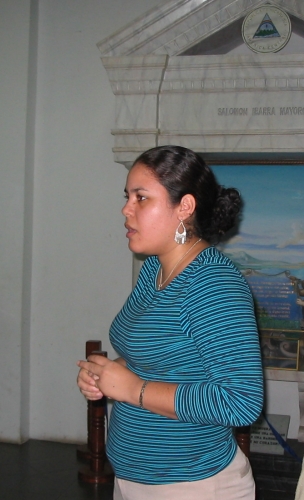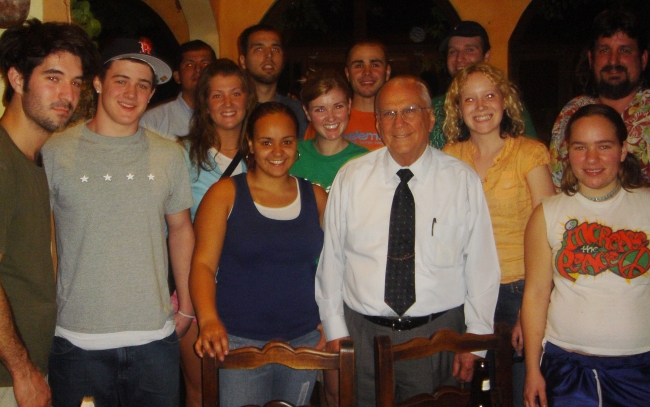|
|
Highlights of
our first full day in Nicaragua included beautiful views, fascinating
and vivid history lessons, a pickup game of kickball on a darkened side
street, and a chance meeting with the president of the country!
I was proud to be leading a group of energetic, consdirate, and curious
students on this study tour. The National Palace was a great location
for our first group photo. Left to right, we are Pam, James, Adrienne,
Krystel, Brandon, Casey, Roberto (our guide), Amy, Alex, Brooks,
Kaitlyn, Ben, and Holly. The photo was taken in a room with a very
important history. It was in this room in 1979 that the Sandinista
rebels held members of Congress hostage in a successful bid to ransom
them for $500,000 and free passage to Panama, from which they launched
the overthrow of the government, using weapons purchased from the
United States with the ransom money.
Pam
and I began our day with an early-morning walk, exploring what turns
out to be quite an affluent part of the city. Houses throughout Latin
America are traditionally surrounded by walls; razor wire is now
apparently a favored way to emphasize security, even when enclosing the
family playground. Our guide explained that in this neighborhood, many
residents were still away for the holiday, explaining the presence of
guards in front of many houses. In the case of one house undergoing
extensive reconstruction, three or four dogs were standing guard. The
Doberman was an impressive jumper -- the photo below was taken at eye
level!
|

|
 |
 |
The National Palace --
which survived the 1972 earthquake -- has become
a major cultural center for the country. It houses the national
library, archives, historical and geographic agency, and many national
treasures. Our very graceful guide interpreted the holdings for us with
great sophistication. In a short time, we had a very thorough
introduction to the history, natural environment, arts, and complex
political reality of Nicaragua. She even agreed to sing the national
anthem for us!
|
 
As a gift to Nicaragua, the Government of Mexico commissioned a massive
mural -- in the style of Diego Riveira -- that dominates the main
entrance to the Palacio Nacional. One side features a stylized image of
Emiliano Zapata, who was the leader of Mexico's 1910 revolution, while
the other features Sandino, who led Nicaragua's effort to expel the
U.S. Marines when they occupied Nicaragua in the 1930s. Each of these
revolutionary figures became the namesake of late-20th century
movements, the Zapatistas and the Sandinistas, respectively.
The Sandino detail shows a coffee worker among those whom Sandino
liberated.
 |

|

|
Our group was quite moved
by two murals, completed by an Italian artist in December 2001 as a
memorial to the worldwide victims of the terrorist attacks in the
United States on September 11 of that
year.
This detail from the second mural reads, "Live and let live, as you
want to live."

The students were impressed by the presence of such a moving tribute in
a place of national importance, and by the fact that it was completed
so soon after the attacks. Two lessons were clear: it was not just the
United States that suffered in the attacks, and sympathy elsewhere in
the world is more widespread and genuine than most people in the United
States realize.
|
 |
 The commemoration of revolution and reconciliation is an
important part of the landscape in downtown Managua. The commemoration of revolution and reconciliation is an
important part of the landscape in downtown Managua.
At far left is a statue honoring worker-revolutionaries who overthrew
the Samoza regime. This view of recent history is contested: notice the
missing left foot, the result of a bomb placed on this statue.
Nearby is a park commemorating the loss of 300,000 Nicaraguan lives in
the violence of the twentieth century. At the center of the park,
created by President Violetta Chamoro, is a lighthouse. It is
surrounded by an earthen berm containing 27,000 decommissioned rifles.
In the background is the Central American Bank, built in 1971, and the
only tall building to survive the devestating 1972 earthquake.
|
Below, Casey
examines a cutout in the berm, which exposes some of the weapons that
were purchased from both the Sandinistas and the Contras in 1991. As
part of the reconcilation process following the war, President Chamorro
arranged to pay fighters on each side to give up their weapons.
 
|
|
|









